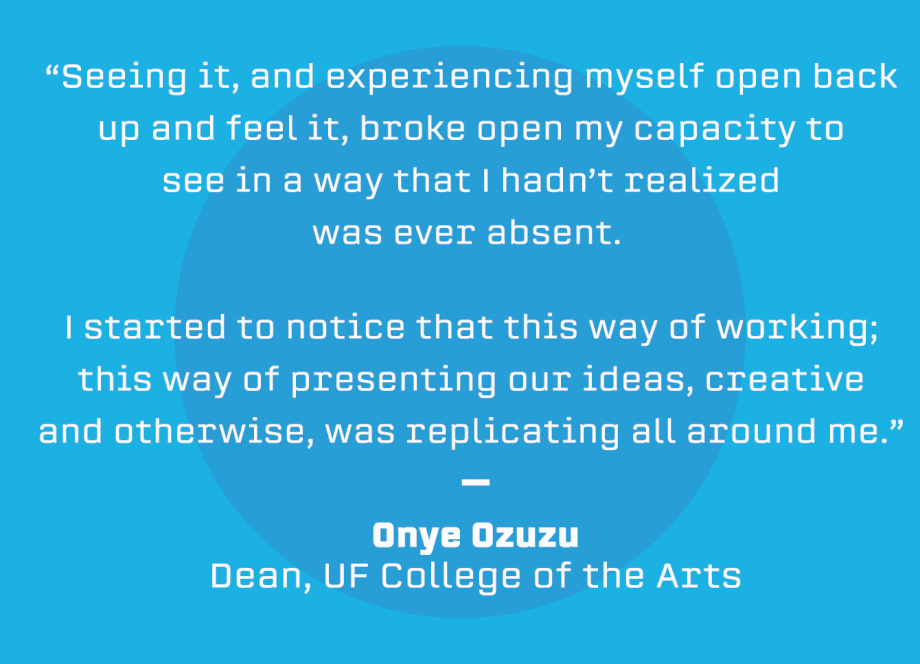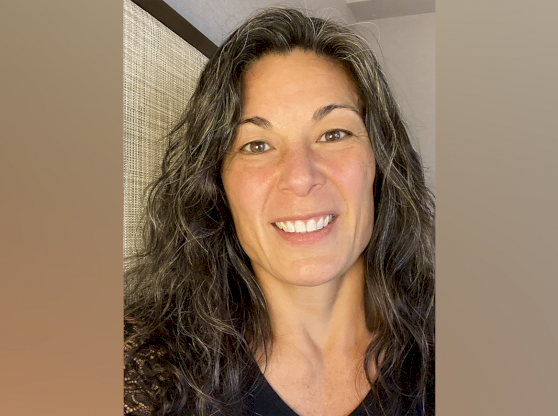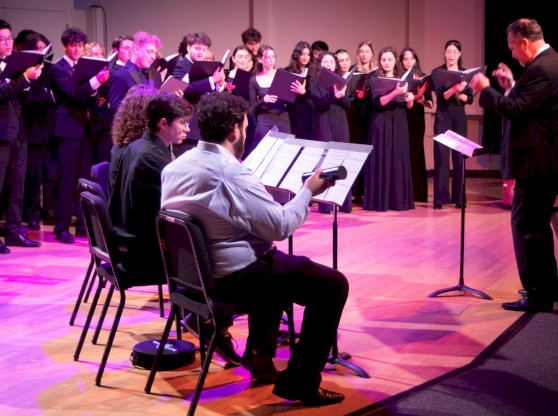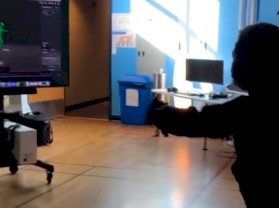I can’t remember how many times in 2020 and 2021 I said, in some Dean’s communication, a version of: “the arts are where innovation and ingenuity will come up with solutions for challenges; challenges the like of which none of us have ever experienced…”
Semester after semester, in the midst of the pandemic and competing crises of a national racial reckoning, and swiftly advancing global political polarization, something had to be said. I am serving as Dean of the College of the Arts. It was my job to speak, and so I did. I said some version of “our creativity is the answer” so many times that I could barely stand the sound of it, myself.
I imagined that I could feel the directors of the schools and institutes in the college rolling their eyes as they read it on the page or listened to me intone it one more time on a Zoom screen. And why shouldn’t they? The reality was that this was not a creative process like any of us knew. There were few choices, here. We were reacting, responding, fixing, salvaging, pivoting, making do, saving, re-tooling, rushing; coping.
On the day-to-day basis, we were just trying to survive (and support our students’ education) through problems that were coming so fast, and with no “pause” button. We were adjusting to ongoing change and uncertainty so relentless that there was no space or time for the usual rhythms of a creative process. This was no crafting of the skill to nurture the ebb and flow of inspiration. This was something else.
Still, I kept saying it: “our artistry, our creativity, will pull us through; will make sense of this,” I think, in part, because it was all I knew to say. But I also kept saying it because, whether or not I felt it at the time, I believed it to be true.
I believed, then, and continue to believe that what we were making in studios and Zoom rooms and administrative meetings would one day (once the intensity of the moment had dissipated, shifted, or passed) present valuable wisdom: that what we made, and how we made it, would reveal something that we would be able to recognize, and through it, begin to see and know what has happened.
Recently, I began to ask myself whether that clarity might be starting to emerge, now. I sent a text out to 35 or so artists whose numbers I happen to have in my phone: curators, deans of arts colleges, performers, artistic directors, composers… Makers of many types. I posed the following question:
“Hi friend. Can you please answer a question for this editorial I am writing? When you think about the work (art) that you have found most compelling, in the emergence from the COVID pandemic into whatever this time is now: can you describe what compelled you in three words? Quick.”
Here, in the order they were received, are their responses.
Change. Strength. Vulnerability.
Experimental. Emergent. Communal.
Hyper-physical. Provocative. Vocabulary.
Radical. Rest. Play.
Occasional. Stark. Quietude.
Endurance. Alleviation. Continuance.
Transported. Community. Infinity.
Deep. In. Common.
Possibility. Resourcefulness. The unknown.
Honest. Inner ferocity. Chorus.
Collaboration. Collectives. Multimedia.
Curious. Intimate. Connected.
Air. Space. Movement.
Sweet. Magnetizing. Effervescent.
Honesty. Possibilities. Daring.
Dedicated. Internal. Journey.
Insular. But reaching.
Fierce. Joy. Fighting.
Urgently. From. Outside.
Rooted. Emergent. Interstitial.
Humanistic. Optimistic. Complexity.
Urgency. Nuance. Care.
Essential. Unifying. Constructive.
I have already written about how seeing the 'Exquisite Moving Corpse' curated by Chip Lord, Jack Massing, and Sean Miller was a pivotal moment in my own personal emergence from whatever state our dueling pandemics — COVID, racial reckoning, the instabilities of our fractious political climate — had put my body, mind, and perception to where it is now. It shifted me. It was something about the brevity, intimacy, and tenderness of 60 short films and the durational expanse of their accumulation. It was something about the palpable care, concern, and generosity of the curatorial act; the bringing of all those individual voices together.
We can feel the intention within the conceiving of this gathering, of selecting and making contact with the artists, of clarifying the parameters of submissions, receiving the submissions — all the endless administrative minutiae it takes to make such a feat of a collective work possible. Yet, curation is not new. Perhaps, like staff members of the Metropolitan Museum of Art expressed in their April 20, 2022 podcast, Seeing Art through a Pandemic Lens, the shared griefs and isolations and delayed processing of a global experience is making what we already know into something new?
Perhaps.
And, perhaps, it was also that threads of meaning emerge through the spaces between multiple individual expressions arranged in juxtaposition. These threads that belong to no one and everyone tap into something particular about the moment that we are sharing. That interstitial evocation made possible by a work of art with so many authors that authorship blurs into a crowd, into a sense of movement — there was something about it that got me in touch with my stillness. It got me in touch with my rigidity; with the place in me that had been holding it together, pushing through a cacophony of definitiveness of outside voices: health directives, administrative leadership, news and media, concerned family — the part of me that had been just saying the thing that needed to be said, whether I could feel it or not.
In 'Exquisite Moving Corpse,' a theme of flight (one of many) emerged between the choices of the collaborating artists. There was a flock arching through an open sky, a butterfly tracing arabesques to land on a human finger; a friend next to the lucky receiver of that visit, shooting their arms into space in celebration. It was believable. It wasn’t an idea one person was asserting as real. It was reality asserting itself amid the collective. Seeing it, and experiencing myself open back up and feel it, broke open my capacity to see in a way that I hadn’t realized was ever absent.
I started to notice that this way of working; this way of presenting our ideas, creative and otherwise, was replicating all around me.
In September, Steven Thomas gathered us in the School of Music for two back-to-back evenings of piano and cello duets performing Beethoven’s complete repertoire for the two instruments. The repertoire functioned as an organizing principle (similarly to the way Lord, Massing, and Miller utilized the Surrealists’ “exquisite corpse” structure) to host a cohort of musicians who took turns contributing to what felt like an endless array of approaches to their instruments; to the repeating and evolving compositional journeys in the music, and to the familiar discursive structure of a duet.
Here, again, the generosity of the facilitation, and the juxtaposed diversity of distinctive voices resonated in me, and with the lonely global ubiquity of living still in a post pandemic reality.
In 2021, one year into lockdown, the annual COTA Staff Retreat took the form of a collaborative mural. The mural was designed to look like a Zoom screen, but in the panels where a thumbnail video or portrait would reside, instead, were symbols chosen by each staff member representing their life outside of work. Professional staff, whose daily jobs normally facilitate the making of art by others, here demonstrated the nuance, sophistication, and depth of their facility with the power of process, collective experience, individual identities, humor, and irony. Their work inspired attention from local and UF Media as word of its impact spread.
See their process here.
I asked College of the Arts Director of Human Resources, Barb Mitola, for her reflections on this out-of-the-ordinary Staff Retreat.
“Our intent was to bring people together again in real space while, at the same time, integrating and acknowledging the level of digital space that had changed our lives in the college, and doing that all under the umbrella of creativity — which is one of the fundamental ways we grapple with the new and the old. The basic premise (that we were to put in our little digital Zoom boxes something that expressed our personal humanity) also represented the juxtaposition of humanity connecting through technology. We wanted to throw our humanity in the face of that which has the potential power to dehumanize us,” she responded.
“We learned that providing a space for people to express how they feel about themselves and new things that are happening in their community is critical to health on all levels, and it strengthens us. And,” Barb told me:
“When you feel on the verge of your or your community's dehumanization or disintegration: fight back with your humanity!”
Our Associate Dean for Research and Strategic Initiatives, Sophia Acord, joined the college during the height of the pandemic, a year into the implementation of our strategic plan. She immediately launched a series of similarly structured gatherings of voices — an effort evocative of the Staff Retreat’s team mural effort, in that it empowers individuals while underscoring the impact of community; of collective effort.
Sophia began to scaffold out an innovative support system for new research, including: the Works-In-Progress Forum Award; a COTA Research Series that includes 'lightning round' sharing of research in a 'pitch' style, and the brilliant idea to offer Strategic Plan Implementation Mini Grants to any member of the college who had an idea to do something that could implement or advance a goal of the plan.
I asked Sophia what she was envisioning as she built the structure. She explains:
“The mini grants were a way to discover and raise up the opportunities and knowledge that already exists in our college that can advance Meta Strategy implementation. It was a way of enabling people to do the work in all corners, and for us to learn from them. They created new resources and capabilities for our college that are being implemented into classes, research, and collaborative work. [And do you know] what surprised me? The great mix of proposals, particularly from grad students, visiting, and adjunct faculty. These members of our community contribute enormously to our potential.”
This way of generating and communicating knowing — a ‘knowing’ that happens in the spaces between many voices speaking next to one another — feels like something we have discovered or rediscovered in this time. It reminds me of that way of communicating that developed in Zoom symposia, or conferences or classes where someone is speaking on camera and others are answering verbally, or asking questions, and simultaneously in the chat questions are being posed and answered, sometimes by the person that’s talking on camera; sometimes by people that are in the chat.
These parallel conversations that sometimes overlap, and sometimes don’t, and that sometimes refer to each other, and sometimes don’t, become a space that offers multiple ways of entering and exiting; of being together and getting what we need from the experience of communing. Perhaps there’s something that we’ve learned in those spaces that we are carrying forward; a way of being deeply individual, and still connected, of valuing that connection and engaging that connection with a kind of intentional leveraging of the power of our shared, multiplied individualities.
Perhaps the internal resistance I was feeling to the sound of my own voice early in the pandemic was more than fatigue with shouting into the unknown. Perhaps it was an inkling of the feeling that is becoming clearer now: that the time of the sole voice, proclaiming to the group, is coming to an end of its effectiveness. Our capacity for collective thinking, making, communicating, and knowing is growing. We are becoming something new.
Thank you for taking the time to consider these questions with us. Thank you to the voices that contributed. Special thanks to Jessi Smith for her editorial hand.
Contributing voices (artists who offered three words on compelling art in the emergence from pandemic, in the order responses were listed above):
Lee Anne Chesterfield
Heidi Boisvert
Paige Cunningham
Kamal Sinclair
Aaron Snyder
Ben Lamar Gay
Kevin Orr
Erika Randall
Damon Locks
Ginger Farley
Raquel Monroe
Colbey Reid
Tony Kolenic
Kendra Foster
Greg Ward
Shoni Currier
Michael Mestas
Nate Bakkum
Peter Carpenter
Kevin Hamilton
Paloma McGregor
James Frazier
Matthew Shenoda
Deandre Carroll



